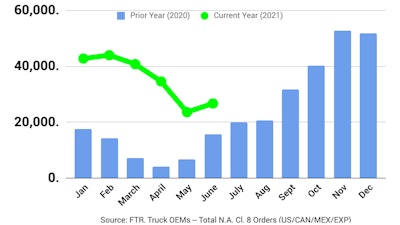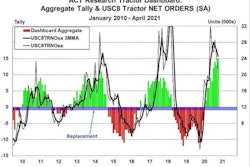
Class 8 net orders in June were 25,700 units, up 11 percent from May, and a 61 percent higher than June of 2020’s COVID-impacted intake, according to an ACT Research’s State of the Industry: Classes 5-8 Vehicles report. FTR reports Class 8 net orders for June were up 13 percent month over month 26,700 units and orders increased 71 percent year over year, with Class 8 orders now totaling 431,000 units for the previous 12 months.
ACT reports Class 5-7, with orders at 22,800 units, slipped 12 percent from May. Demand in this segment faced a tougher year-ago comparison, but still outpaced June 2020 by 26 percent, the report states.
“With 2021 backlogs essentially filled and 2022 order activity remaining calendar constrained, North American Classes 5-8 orders in June moved sideways from May,” says Kenny Vieth, ACT president and senior analyst. “We reiterate that order moderation aligns with expectations, driven by the supply of open build slots in 2021 and not fully opened 2022 orderbooks, rather than any material fall-off in demand for equipment.”
Regarding the heavy-duty market, Vieth says, “With orders below recent activity, the three- and six-month net order SAARs continued to moderate but remain at still-robust run rate levels. June’s Class 5-7 orders slowed, in a still-supportive vehicle demand environment, with three and six-month SAARs remaining elevated.”
FTR says the June Class 8 order total is positive because it indicates this order cycle bottomed out at 24,000 orders in May, which is almost double the typical low point. FTR expects a surge of orders when all the OEMs start booking for 2022. This could happen as early as July.
“It appears that June was a transitory month. Orders for delivery in 2021 are ending, as fleets grabbed the remaining build slots for 2021 and there are indications that some early orders for 2022 were added to the mix. Presently, the first quarter of 2022 is uncertain from a production standpoint because unfilled orders from 2021 are expected to roll into 2022. Supply chain issues continue to restrict OEM production, creating a shortage of new trucks and generating a great deal of pent-up demand,” says Don Ake, FTR vice president of commercial vehicles.
“Fleets are still in desperate need of new trucks to handle the surge in freight growth. The full opening of the economy continues to strain deliveries, with service levels falling at some of the most reliable carriers. Spot freight rates remain highly elevated, an indicator that freight capacity is being greatly stressed,” Ake says.
Complete industry data for June, including final order numbers, will be published by ACT and FTR later this month. ACT’s State of the Industry: Classes 5-8 Vehicles report provides a monthly look at the current production, sales, and general state of the on-road heavy- and medium-duty commercial vehicle markets in North America.











